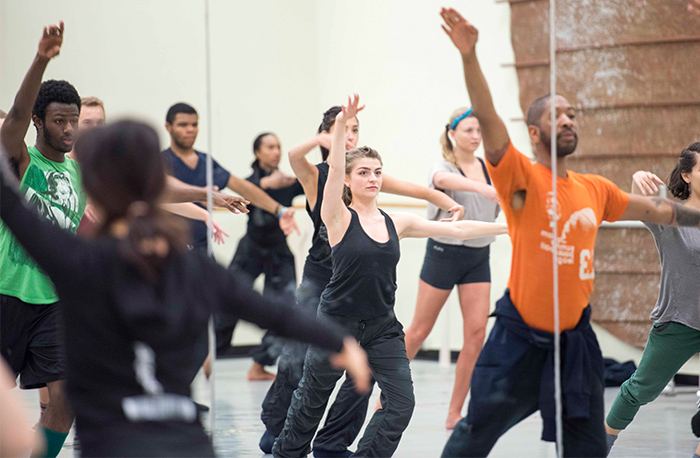Abraham.In.Motion Residency
Tune In Before Select Renegade Performances
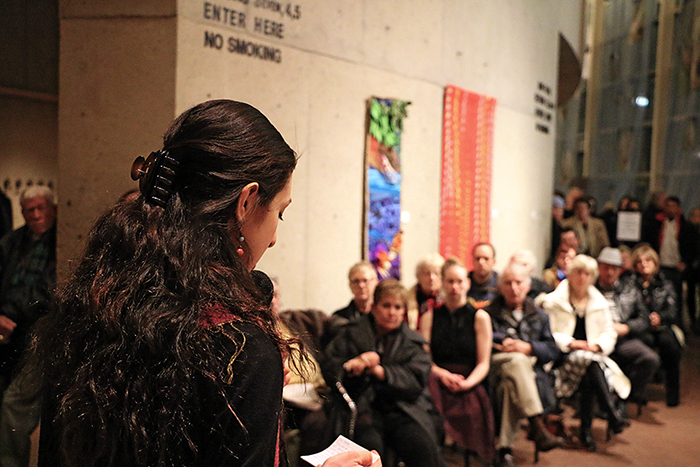 21st Century Artist Intern Hillary Kooistra gives a pre-show Tune In for Trisha Brown Dance Company’s performance February 21, 2015.
21st Century Artist Intern Hillary Kooistra gives a pre-show Tune In for Trisha Brown Dance Company’s performance February 21, 2015.
Tune In with UMS for a brief pre-performance talk before select Renegade series performances; the next Tune In is before Bill Frisell’s solo performance on 3/12. Just 15 minutes long, each Tune In offers interesting information and provocative questions for thinking about, listening to, and watching the performance. The Renegade series celebrates artistic innovation, experimentation, and discovery.
Student Spotlight: On the Road with Trisha Brown
Editor’s note: During the summer of 2014, UMS launched a new 21st Century Artist Internship program. Four students interned for a minimum of five weeks with a dance, theater, or music ensemble part of our 2014-2015 season. Hillary Kooistra is one of these students. She spent the summer in New York and on the road with the Trisha Brown Dance Company.
Below she recounts her travels with the company. The Trisha Brown Dance Company will perform Proscenium Works, 1979-2011 at the Power Center on February 21-22.
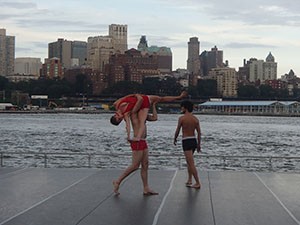
TBDC Dancers Tara Lorenzen, Nick Strafaccia, and Olsi Gjeci perform “I’m going to toss my arms — if you catch them they’re yours” on Pier 15 at the South Street Seaport in NYC.
As an embedded intern with the Trisha Brown Dance Company (TBDC), I worked alongside TBDC administrators and artistic directors, observed the company in rehearsals, befriended the dancers, learned repertory and improvisation/ composition techniques from TBDC alumni, and watched many, many performances. During my internship, I accompanied the dancers and TBDC artistic staff on two trips. This gave me a taste of life on the road for a dancer in an international touring company and allowed me to develop a deep understanding of the diverse performance programs that the Trisha Brown Dance Company presents.
The first stop on my personal tour with TBDC was Annandale-on-Hudson, New York, where the company was invited to perform selections from its Proscenium Works, 1979-2011 tour (the final tour of Trisha’s repertory works specifically choreographed for the stage, coming to Ann Arbor in February). After a NYC performance of “I’m going to toss my arms, if you catch them they’re yours” (fondly referred to by the company as “Toss”), I joined the company in a 15-passenger van headed toward Bard College. Though I was new to the touring artist lifestyle, I quickly learned that this pace is typical for the dancers. In one day, they danced on a pier overlooking the East River, drove upstate from New York City, and prepared for the next round of performances!
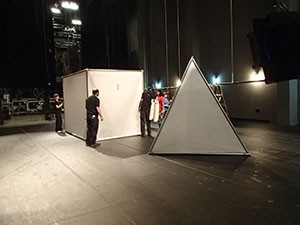
Load-in of Robert Rauschenberg’s set piece for “Set and Reset” prior to the company’s Bard SummerScape performance.
We arrived at Bard late that night. Throughout the weekend, I found myself enchanted by little details of tour life, as mundane as they may seem. I loved the trips to the grocery store to stock up on weekend meal essentials, the hospitality provided by the presenter, and the pre-rehearsal or performance rituals of each individual dancer before they all came together as a group; these helped me recognize touring as a realistic and obtainable aspect of a professional dance career, as opposed to something far-fetched and imaginative.
Even more exciting for me was the opportunity to watch the program in technical rehearsal and performances. The company presented “I’m going to toss my arms — if you catch them they’re yours,” “Set and Reset,” and “If You Couldn’t See Me.” They will bring the latter two to Ann Arbor. Seeing Diane Madden, co-associate artistic director of the company, lead the dancers in onstage rehearsals was like getting a sneak peek at the man behind the curtain before the grand unveiling.
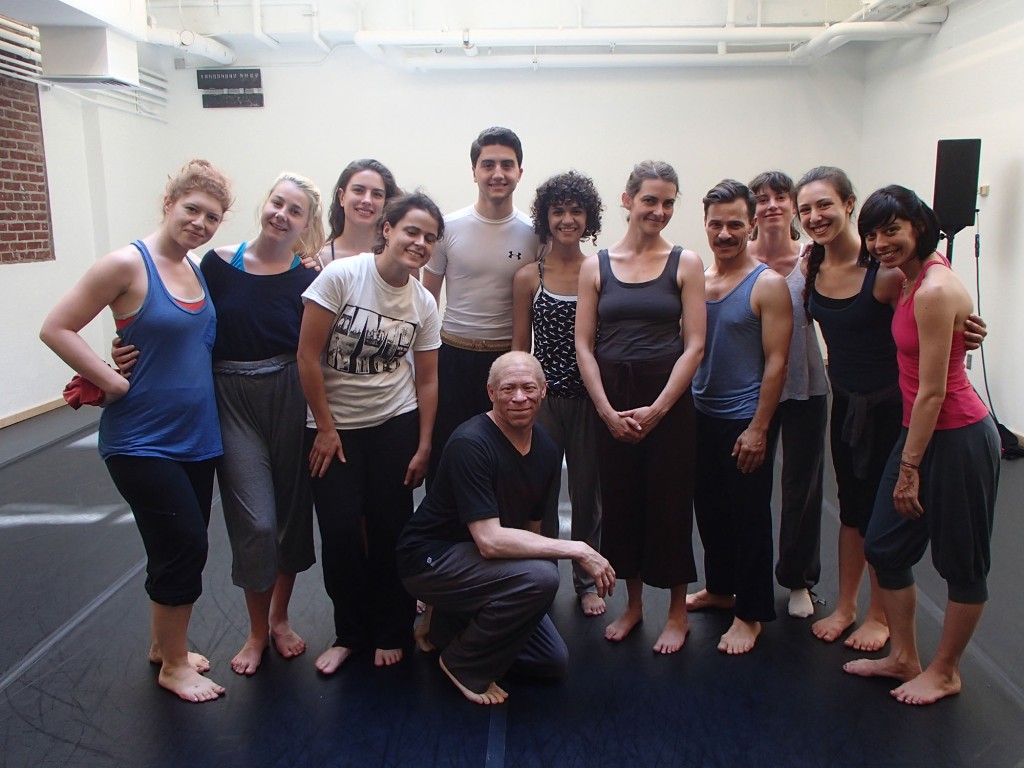
TBDC Summer Intensive students with Company alumnus Keith Thompson.
My impression of the works was further enhanced when I watched them in performance with full costumes, lights, and set. Trisha valued the visual design elements of dances as much as she did the movement — collaborating frequently with artists such as Robert Rauschenberg and Donald Judd — and her choreography breathed a new light with the integration of additional production elements. I saw the program three times, and each time I noticed something new, but also recognized familiar moments or images. I’ve grown to admire this about Trisha’s work: her dances have multiple layers, but follow a cohesive line that runs parallel to the surprising twists and turns.
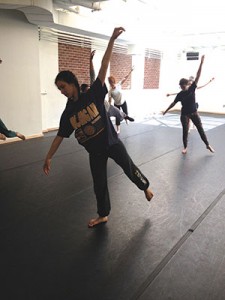
Dancing a part of “Newark” at the TBDC Summer Intensive.
After our weekend at Bard, I parted ways with the company. I returned to New York to serve as the on-site coordinator for the TBDC Summer Intensive, a three-week workshop that offered up to six hours of technique, repertory, and composition classes each day. I acted as a point of reference for students and teachers and was also able to dance! Classes allowed me to further explore the works I had grown to know intimately as an audience member, and to embody the movement that I only saw and read about up until this point. Composition/improvisation class revealed the techniques behind choreographic concepts I had observed in Trisha’s work and allowed me to apply them to my own dance making. Some of what I learned will surely find its way into the work I create for my Senior BFA Concert this coming April!
In August, I reunited with the company for my second tour experience of the summer, a performance of Trisha’s Early Works at the Lynden Sculpture Garden in Milwaukee, WI. Before she began choreographing larger works such as “Set and Reset” for the proscenium stage, Trisha concentrated on shorter, site-adaptive dances for alternative venues such as museums, rooftops, and parks. The company performs these works for events throughout NYC and international tour venues and will continue to concentrate on these types of performances after the conclusion of Proscenium Works, 1979-2011.
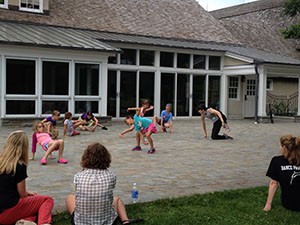
TBDC dancer Tamara Riewe leads young members of Lynden’s summer camp in demonstrating poses inspired by the sculptures in the garden.
This trip to Milwaukee marked my first foray into site work, and I quickly learned how much extra effort must go into presenting dance in any area other than a stage. We spent the first day at the Garden traveling from spot to spot, considering which dances would work best in front of which sculptures, identifying the strongest vantage points, and mapping a path for the audience to travel between locations. Since all the company members were not present for the initial site visit, I often assumed the role of a stand-in to help the team visualize dances in different locations. I was able to try some of Trisha’s choreography and tasks on site, doing her signature “Group Primary Accumulation” while floating on a raft in the middle of a pond and walking down the side of a tree for “Spiral.”
Trisha’s Early Works are full of these fun tasks and were an absolute blast to watch in performance. In one work titled “Sticks,“ dancers moved through a series of postures while balancing long, wooden sticks on their heads. This lighthearted performance atmosphere contributed to the informal relationship established between the dancers and audience. Throughout the performance, the dancers interacted with us, acknowledging when something wasn’t working and inviting us to join in on their fun. This, I discovered, was a delightful difference between the Early Works and Proscenium Works programs, the latter of which demonstrates a traditional separation between performers and audience.

TBDC members perform Sticks at the Lynden Sculpture Garden in Milwaukee, Wisconsin.
Seeing the Early Works really sparked my interest in dance for alternative spaces, which I’ve been exploring since I’ve returned to Michigan. This marks one of the many ways that my travels with the company influenced my impressions of Trisha’s work and view of the dance field. I grew leaps and bounds throughout the summer, but my experience would not have been complete without the opportunity to climb in a van with 11 professional dancers or to walk down the side of a tree in front of the company’s associate artistic director. I began my rich and unique experience as an intern “embedded” with the company, but emerged as a knowledgeable, conversant member of the TBDC family.
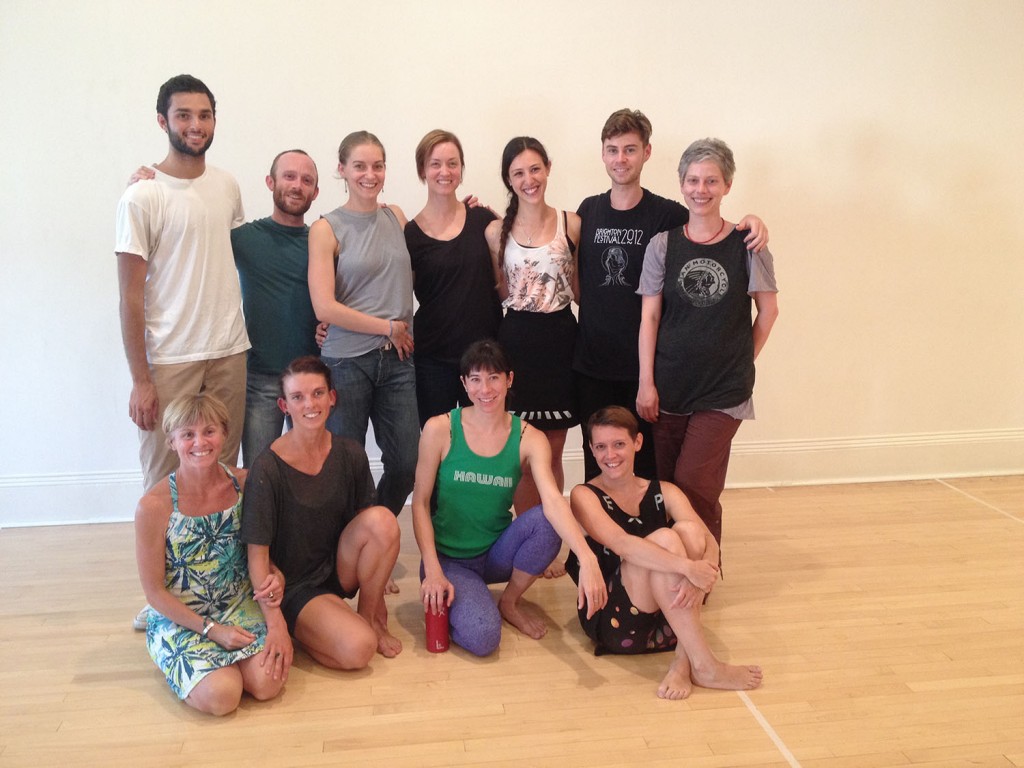
Smiling with Carolyn Lucas, Diane Madden, and the TBDC company members. Thank you for a wonderful summer!
Artist Interview: Jamie Scott, Trisha Brown Dance Company Dancer
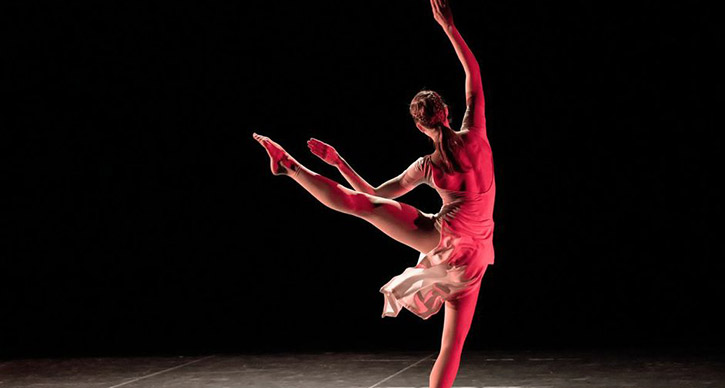
Photo: Trisha Brown Dance Company dancer Jamie Scott performs “If You Couldn’t See Me.” Photo by Alice Gebura.
The Trisha Brown Dance Company performs in Ann Arbor on February 21-22, 2015. Hillary Kooistra, University of Michigan Dance student and UMS intern, spent five weeks with the company during Summer 2014 as part of a new internship program. During her internship, Hillary had the chance to work with the company, and also to sit down with company members and interview them.
Her first was with dancer Jamie Scott. Jamie started dancing with the company as an apprentice in February 2012.
Hillary Kooistra: You’ve actually performed at UMS before with the iconic Merce Cunningham Dance Company. How has your work with the Trisha Brown Dance Company (TBDC) compared to your experience with Merce Cunningham?
Jamie Scott: It’s a very different way of approaching movement for me. A lot of the work that I’ve been doing since I joined TBDC has been re-calibrating the way that I think about movement, the way that I see movement, and the values that I give to different types of movement. There are many similarities, too, with learning repertory that’s been done before and with finding a way to re-inhabit works that have been done.
HK: Aesthetically, what would you say are some of the differences between Trisha’s work and Merce’s work?
JS: They strike a very similar aesthetic or taste from my point of view. But I’d say the biggest difference is that Merce’s work is very externally driven. The movement is very inorganic, and the task is finding a way to do the impossible, to use your muscles and everything you have to make these tasks possible. With Trisha, it’s almost the opposite. There are equally impossible tasks, but I’m trying to strip away as much as I can and re-calibrate force and energy. To find a way to arrive at the impossible form the inside out, rather than the outside in.
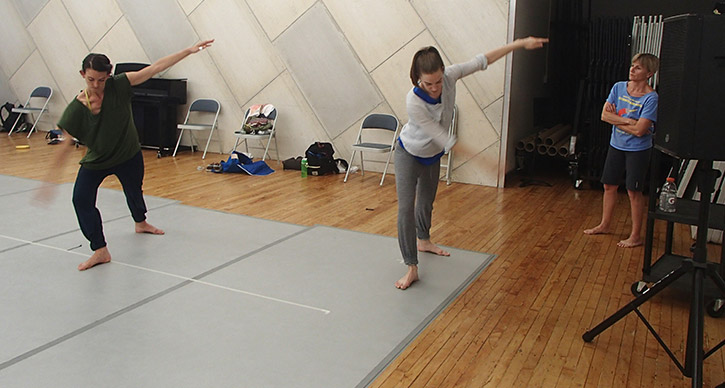
Photo: Jamie and Cecily Campbell (who shares the soloist role in “If You Couldn’t See Me”) rehearse part of the solo with Associate Artistic Director Diane Madden. Photo by Hillary Kooistra.
HK: At Power Center, you’ll perform Trisha Brown’s solo “If You Couldn’t See Me.” I know that you didn’t get to work directly with Trisha Brown in the studio, so how did you prepare, learn, and embody her movement for this solo?
JS: Leah Morrison, another dancer who has performed this solo, taught it to me along with Carolyn Lucas, one of the associate artistic directors of the company. After Leah left the company, we sat down with this amazing archive of footage of Trisha when she was first making the solo. In the video, she is going through the process of creating the movement, just so, and then taking it a step further, and then paring it back. We kind of went along with her whole process, and in doing that we got a lot of physical information that then translated into what you’ll see on the stage.
HK: I’ve noticed that the company often rehearses without music. When you do put on the music, what is that extra layer like?
JS: Actually, working with Merce Cunningham was similar in that respect. We never rehearsed to music, so I’ve gotten used to that. It’s sort of on and off, on and off. But I remember that the first time that I performed to music after rehearsing in silence, it added another dimension in the space. It opened up my awareness, my perception of the space, and gave me something else to interact with. Very tangible, actually. Oddly enough, it seemed very tangible.
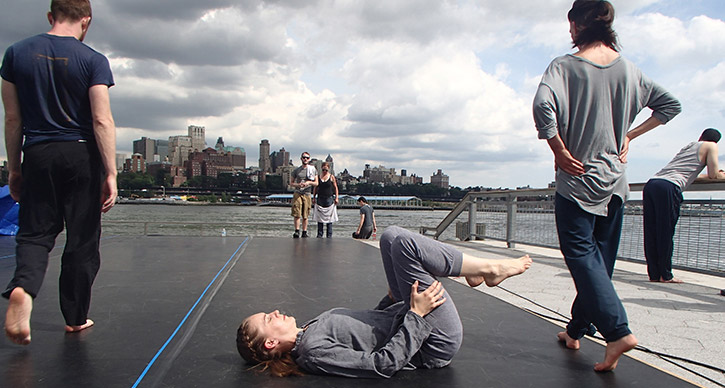
Photo: Jamie warms up before the Company’s performance of “I’m Going to Toss my Arms–If You Catch Them They’re Yours” at Pier 15 for the 2014 River To River Festival in New York City. Photo by Hillary Kooistra.
HK: What would you say is the most challenging aspect of Trisha Brown’s work?
JS: I would say that it’s being honest with movement and not embellishing, not exaggerating, but trusting the simplicity of it.
HK: Trisha’s known as one of the most iconic post-modern dancers and choreographers of our time, partially because of that quality of her movement vocabulary. Do you think that this term “post-modern” accurately characterizes her work?
JS: If we’re talking about stripping away the fluff, which is one of the big tenets of post-modernism in dance, really getting back to the human and getting rid of the fluff, this work continues to do that. This work is all about that, especially the earlier programs. The later work begins to explore, and as with any great artist, the trajectory goes somewhere else.
Read more of Hillary Kooistra’s behind-the-scenes coverage of Trisha Brown Dance Company.
Artist Interview: Leah Ives, Trisha Brown Dance Company Dancer
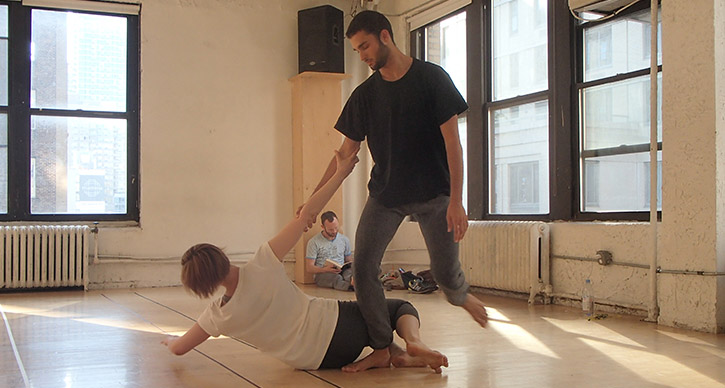
Photo: Trisha Brown Dance Company dancer Leah Ives and fellow dancer Marc Crousillat rehearse a duet from one of many pieces of repertory the two must learn as new members of the Company. Photo by Hillary Kooistra.
The Trisha Brown Dance Company performs in Ann Arbor on February 21-22, 2015. Hillary Kooistra, University of Michigan Dance student and UMS intern, spent five weeks with the company during Summer 2014 as part of a new internship program. During her internship, Hillary had the chance to work with the company on the administrative side and to also sit down with company members and interview them.
Her second interview was with dancer Leah Ives. Leah started dancing with the company in June 2014, and she is also a U-M Dance graduate.
Hillary Kooistra: You’re one of the newer members of the company. Trisha Brown Dance Company is an iconic post-modern company that’s currently in a transition period, and this performance is part of a tour that showcases major stage works. What’s it like to enter rehearsals when the company is in a transition period?
Leah Ives: It’s hard for me to know what it was like for people to enter when the company was not in a transition period. I think we’re very focused on the performances that are coming up, and so in some ways, I imagine that the transition hasn’t fully affected the company quite yet. I feel lucky to be able to jump in and have the chance to perform these works.
I also recognize that this movement hasn’t had as much time to settle into my body and that I have a lot to learn when compared to the other dancers who may have performed these roles and who have had years with these movements and with the pieces settling onto them. I feel like I have a large task to complete in a very short period of time.
HK: Did you always know that you wanted to dance for Trisha Brown?
LI: I was always interested in the company. Once I studied the movement and the repertoire, I found it really satisfying and intriguing mentally. There is a lot of specificity, a lot of attention to detail, and then a lot of of abandoning of that and seeing where that goes in the body.
So yes, I was always interested in the company, but there’s a point when a dancer recognizes that she’s one of many that would love to work for a full-time company, and an iconic company like Trisha Brown Dance Company at that. So, I was content studying the work and getting what I could from the work as a technique, as movement. I am so thrilled to be one of the lucky people who get to actually perform the work.
HK: What are you most excited to share with our Ann Arbor audience? I know the company is doing “Newark” as well as “Set and Reset” (1983).
LI: I’m excited to show the sense of weight and peacefulness in the body that Trisha Brown’s movement is known for. The sort of physics that play through the body in her work may be very different from some of the work that has been presented recently at UMS. I think the pieces we’re performing are really dynamic works, really exciting works, very full of bodies, movement, and interplay between dancers. They’re very exciting pieces to watch.
HK: You graduated from the University of Michigan with a BFA in Dance in 2007. Can you think of work that you did as an undergraduate student at U-M that reminds you of the work you’re currently doing?
LI: While I was there, choreographer Alexandra Beller set a piece with us, and both the interaction between dancers and the grounded-ness of the movement was similar to Trisha Brown’s work. Choreographer Doug Varone also set a piece with us, and the sense of momentum in that piece was very similar to Trisha Brown’s work, the sense of feeling the weight of the arms and the swing through the body. I had also studied with former Trisha Brown Dance Company dancers during the summers and that has really helped me in performing these works.
HK: How is Trisha Browns’s work differed from other dance works that you’ve encountered in your career so far?
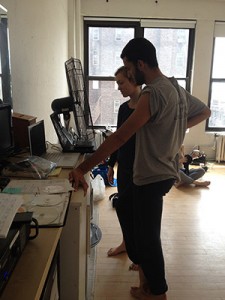
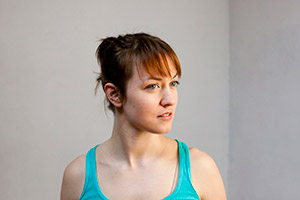
Photos: On left, Leah and fellow dancer Marc Crousillat review choreography from a DVD during some downtime in rehearsal. Photo by Hillary Kooistra. On right, Leah Ives. Photo courtesy of the artist.
LI: Trisha’s work is incredibly intricate in a way that I’ve not encountered very often. It’s very visual, the spacing between dancers is incredibly important. Trisha seemed to have a clear vision of what she wanted in each moment, so we are always trying to re-create that vision.
It’s a tricky process because we are looking at one version of that vision from when the work was originally created, and then maybe another version from ten years later and on a different stage and with different people. This process is very different from what I’ve done in the past.; my other projects have mostly been new works. This concept of taking these roles that were created by someone else and were modified through her body, put onto another body that may or may not have affected the role, and then taught to the person who is now teaching me, is a really interesting way of translating movement. It’s a great challenge. I’m not quite there in the rehearsal process yet.
HK: We’re really looking forward to seeing you on stage back in Ann Arbor! Before we end our chat, can you tell us about your most memorable UMS experience while you were at the University?
LI: The most memorable is hard to pick. I was fortunate enough to live fairly close to Ann Arbor growing up. I lived in Brighton, Michigan. So when I was in Middle School, we had a field trip to the Power Center to see Elizabeth Streb’s Dance Company. That was my first experience with modern dance. It was really exciting, especially at that age, to see people flying through space and their use of trampolines and technology (the soundtrack was based on the bouncing). That stuck with me for a long time.
Another experience that stuck with me was during the Royal Shakespeare Company residency. There were many programs beyond their performances, one of which included a competition of interpretations of a sonnet. I had made a dance based on a sonnet and got to perform it for Patrick Stewart. And I didn’t place, but it’s still something I can brag about! It was a great brag-worthy experience.
Read more of Hillary Kooistra’s behind-the-scenes coverage of Trisha Brown Dance Company.


